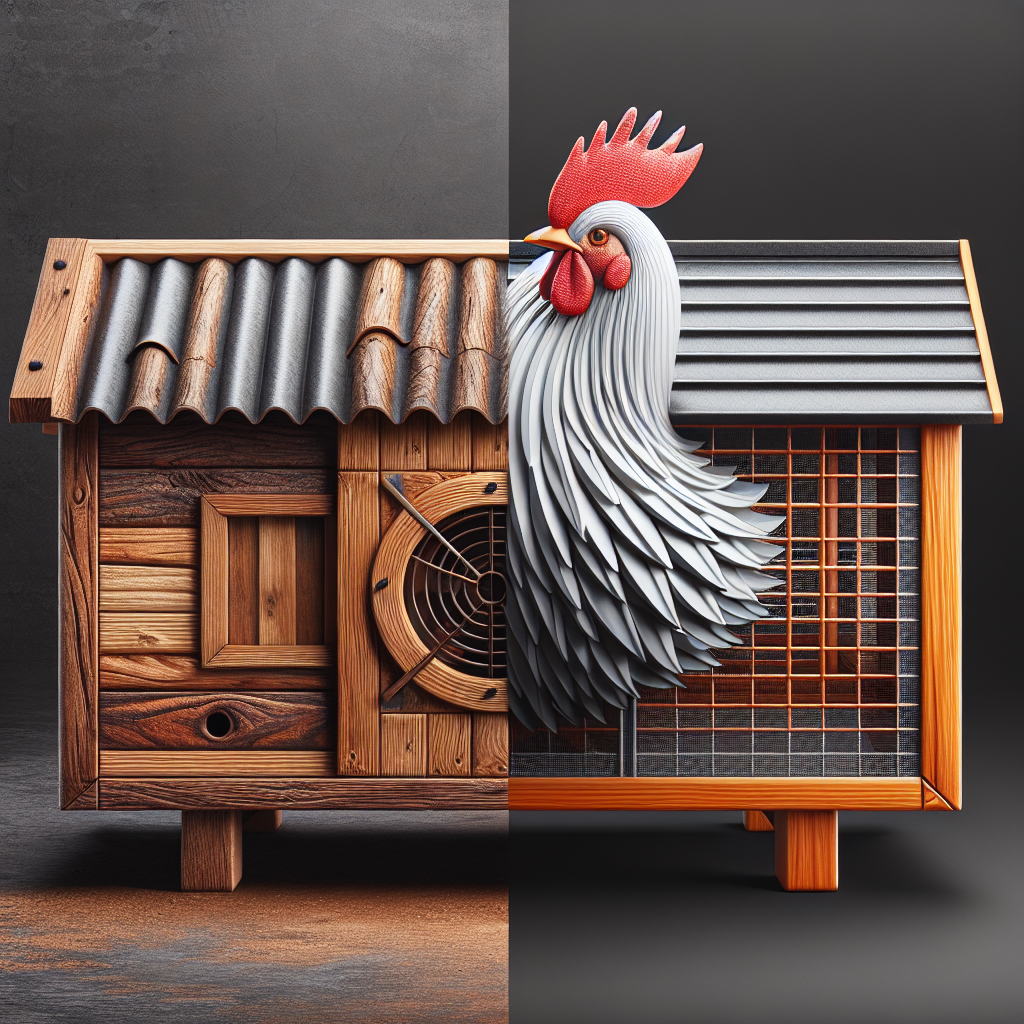Imagine having a cozy and comfortable chicken coop, where your feathery friends can feel snug and protected from the outside elements. But have you ever wondered how the materials you choose for your coop actually impact the temperature and insulation inside? Well, the answer might surprise you. In this article, we will explore the fascinating world of coop materials and how they can alter the climate within your coop, ensuring a pleasant environment for your beloved chickens. So, let’s get ready to learn how different coop materials can influence temperature and insulation, and create a haven for your feathered companions.
Introduction
In order to create a comfortable and healthy environment for your feathered friends, it is important to consider the impact of temperature and insulation in your coop. The temperature inside the coop can significantly affect the well-being and productivity of your chickens. Additionally, proper insulation can help regulate the temperature and protect the birds from harsh weather conditions. When selecting the materials for your coop, it is crucial to choose ones that will provide optimal insulation and maintain a consistent temperature. In this article, we will explore the factors influencing temperature and insulation in a coop, the different coop materials available, and their influence on temperature regulation and insulation.
The Importance of Temperature and Insulation in a Coop
Maintaining the right temperature inside the coop is essential for the health and well-being of your chickens. Extreme temperatures, whether too hot or too cold, can have a negative impact on their egg production, growth, and overall health. Chickens are particularly sensitive to temperature fluctuations, so ensuring a comfortable and consistent environment is vital.
Insulation plays a crucial role in regulating the temperature within the coop. It helps to keep the coop warm during colder months and cool during hot summers. By preventing outside elements from seeping in, insulation maintains a more stable and comfortable temperature for the chickens, regardless of the weather conditions.
Factors Influencing Temperature and Insulation
Several factors influence the temperature and insulation within a coop. By understanding these factors, you can better plan for and implement strategies to ensure a comfortable environment for your chickens.
Climate
The climate in which your coop is located will have a significant impact on its temperature regulation and insulation needs. Areas with extreme temperature ranges may require more insulation to maintain consistent temperatures within the coop. Cold or hot climates may necessitate additional measures to keep the coop warm or cool, respectively.
Coop Design
The design of your coop can also affect its ability to regulate temperature and provide insulation. Factors such as size, shape, and the materials used in the construction of the coop can all contribute to its thermal properties. Coops with smaller volumes or designs that allow for better airflow may require more insulation to maintain a stable temperature.
Ventilation
Proper ventilation is essential in any coop, as it helps regulate temperature and moisture levels. Ventilation allows for the exchange of air, preventing the accumulation of humidity and the buildup of harmful gases. However, excessive ventilation can also lead to heat loss during colder months. Finding the right balance between adequate ventilation and insulation is crucial.
Sun Exposure
The amount of sun exposure your coop receives throughout the day can impact its temperature. Direct sunlight can raise the temperature inside the coop, especially during summer months. Providing adequate shade or using materials that reflect sunlight can help keep the coop cooler.
Different Coop Materials and Their Influence on Temperature and Insulation
Choosing the right coop materials is essential in maintaining optimal temperature and insulation. Different materials have varying thermal properties, which can significantly impact the temperature regulation within the coop.
Wood
Wood is a popular and traditional material used in coop construction. It offers several benefits when it comes to temperature regulation and insulation.
Natural Insulator
Wood is a natural insulator, meaning it can help retain heat and keep the coop warm during colder months. It provides a barrier against outside temperatures, reducing heat loss.
Breathable and Moisture-Regulating
Wood has the advantage of being breathable, allowing for proper airflow within the coop. This helps regulate moisture levels and prevent the buildup of condensation, reducing the risk of diseases.
R-value
The R-value measures the resistance of a material to heat flow. Wood has a moderate R-value, meaning it provides a decent level of insulation. However, additional insulation may be needed to achieve optimal thermal efficiency, particularly in extreme climates.
Metal
Metal coops are often chosen for their durability and ease of maintenance. However, they have different considerations when it comes to temperature regulation and insulation.
Conducts Heat and Cold
Metal conducts heat and cold more readily than wood. This means that during hot summers, a metal coop can become significantly hotter. Similarly, in cold weather, metal coops can quickly lose heat.
Requires Additional Insulation
Due to its conductivity, a metal coop requires additional insulation to maintain a stable temperature. This may involve adding insulation materials to the walls or using different building techniques.
Durability
Although metal coops may require more insulation, they often boast higher durability than other materials. They are resistant to pests and can withstand harsh weather conditions.
Plastic
Plastic coops are gaining popularity due to their affordability and ease of maintenance. However, their insulation properties are more limited compared to other materials.
Limited Insulation
Plastic has lower insulation properties compared to wood or metal. It does not retain heat as effectively, which can be a disadvantage in colder climates.
Heat Retention
On the flip side, plastic coops may retain more heat during hot weather. Proper ventilation is crucial in ensuring the coop doesn’t become excessively hot for the chickens.
Easy to Clean
One advantage of plastic coops is their ease of cleaning. They can be quickly hosed down and wiped clean.
Concrete
Concrete coops provide unique advantages when it comes to temperature regulation and insulation.
High Thermal Mass
Concrete has a high thermal mass, meaning it can absorb and store heat. This can help maintain a stable temperature within the coop as it slowly releases stored heat during colder nights.
Slow to Heat and Cool
Due to its thermal mass, concrete coops take longer to heat up and cool down. This can be beneficial in areas with extreme temperature fluctuations.
Moisture Resistance
Concrete is highly moisture-resistant, reducing the risk of water damage or mold growth. This can contribute to a healthier environment for the chickens.
Comparison of Coop Materials
Considering the various coop materials discussed, here is a comparison of their insulation properties, cost, durability, and aesthetics:
Insulation Properties
Wood provides natural insulation and moderate R-value. Metal requires additional insulation for optimal thermal efficiency. Plastic has limited insulation properties. Concrete has high thermal mass but may require additional insulation in extreme climates.
Cost
Wood and plastic coops tend to be more affordable, while metal and concrete coops can be more expensive.
Durability
Metal and concrete coops offer higher durability and resistance to pests and weather conditions. Wood coops require regular maintenance but can still last a long time if properly cared for. Plastic coops may have lower durability.
Aesthetics
Wood coops are often considered more aesthetically pleasing and can blend well with the surrounding environment. Metal and plastic coops may be less visually appealing, while concrete coops have a more industrial look.
Additional Insulation Techniques for Coops
In addition to choosing the right coop material, there are several insulation techniques you can implement to further regulate the temperature within the coop:
Insulating the Floor
Adding insulation material or using insulated flooring can prevent heat loss through the floor. This can be particularly useful in colder climates.
Insulating the Walls
Insulating the walls of the coop with materials such as foam boards or reflective insulation can help maintain a stable temperature. This is especially important for materials with lower insulation properties, such as metal or plastic.
Roof Insulation
Insulating the coop’s roof can prevent heat loss during colder months and keep the coop cooler during hot summers. This can be achieved by using insulation materials or reflective coatings.
Windows and Doors
Properly sealing windows and doors can prevent drafts and heat loss. Weatherstripping and adding insulation around these openings can improve temperature regulation.
In conclusion, understanding the importance of temperature and insulation in your chicken coop is crucial for the health and well-being of your feathered friends. Factors such as climate, coop design, ventilation, and sun exposure all play a role in temperature regulation. The choice of coop material is also significant, with wood, metal, plastic, and concrete all having different insulation properties. Consideration should be given to their insulation properties, cost, durability, and aesthetics. By implementing additional insulation techniques, such as insulating the floor, walls, roof, windows, and doors, you can create a comfortable and consistent environment for your chickens year-round.




